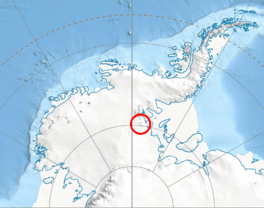Hyde Glacier facts for kids
Quick facts for kids Hyde Glacier |
|
|---|---|

Location of Heritage Range in Western Antarctica
|
|
| Type | tributary |
| Location | Ellsworth Land |
| Coordinates | 79°48′00″S 83°42′00″W / 79.80000°S 83.70000°W |
| Thickness | unknown |
| Terminus | Union Glacier |
| Status | unknown |
Hyde Glacier (79°48′S 83°42′W / 79.800°S 83.700°W) is a short, icy river found in a very cold place called Antarctica. It flows east through the Edson Hills and joins a bigger ice stream known as Union Glacier. This area is part of the Heritage Range.
Contents
What is Hyde Glacier?
Hyde Glacier is a type of glacier, which is a huge, slow-moving river of ice. Glaciers form over many years as snow piles up and gets pressed into thick ice. Hyde Glacier is a "tributary" glacier. This means it flows into a larger glacier, just like a small river flows into a bigger one.
Where is Hyde Glacier located?
Hyde Glacier is located in Ellsworth Land, a part of West Antarctica. Antarctica is the coldest continent on Earth. It is covered almost entirely by a thick ice sheet. The Heritage Range, where Hyde Glacier is found, is a group of mountains within the larger Ellsworth Mountains.
How was Hyde Glacier discovered and named?
Scientists and explorers have been mapping Antarctica for many years. Hyde Glacier was mapped by the United States Geological Survey (USGS). They used surveys done on the ground and photos taken from airplanes by the United States Navy. These mapping efforts happened between 1961 and 1966.
The glacier was named by the Advisory Committee on Antarctic Names. This committee is in charge of naming places in Antarctica. They named it after William H. Hyde. He was a scientist who studied the ionosphere. The ionosphere is a part of Earth's upper atmosphere. William Hyde worked at a research station called Little America V Station in 1958.
Why are glaciers important?
Glaciers like Hyde Glacier are very important for our planet. They hold a huge amount of the world's fresh water. When glaciers melt, this water flows into the oceans. Scientists study glaciers to understand how Earth's climate is changing. The way glaciers move and change can tell us a lot about our planet's health.


